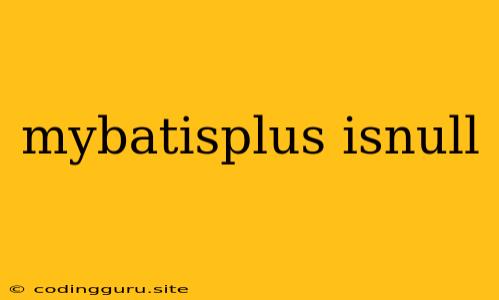Mastering isNull in MyBatis-Plus: A Comprehensive Guide
MyBatis-Plus, a powerful extension of MyBatis, offers a streamlined and efficient approach to database interactions in Java applications. One crucial aspect of data manipulation is handling null values, and MyBatis-Plus provides a concise and elegant solution through the isNull function. This guide delves into the intricacies of isNull in MyBatis-Plus, empowering you to effortlessly manage null values in your queries.
Why isNull is Essential:
In the realm of database operations, null values are an unavoidable reality. These "empty" values represent the absence of data, and handling them correctly is crucial for maintaining data integrity and ensuring accurate query results.
Imagine a scenario where you want to fetch all customers who haven't provided their email address. Using traditional SQL, you might write a query like this:
SELECT * FROM customers WHERE email IS NULL;
However, MyBatis-Plus offers a more expressive and efficient way to achieve this:
List customers = customerMapper.selectList(new QueryWrapper()
.isNull("email"));
The isNull function within the QueryWrapper object simplifies the process, making your code more readable and maintainable.
Understanding isNull in Action:
Let's break down how isNull works in MyBatis-Plus:
- Targeting the Column: The
isNullfunction accepts a single argument: the name of the column you want to check for null values. In our previous example,emailis the target column. - Generating the SQL: Behind the scenes, MyBatis-Plus generates the equivalent SQL query using the provided column name. The generated SQL will include an
IS NULLclause. - Selecting Data: The query will return all records where the specified column is null.
Expanding Your isNull Horizons:
While isNull is powerful in its simplicity, its capabilities extend beyond basic null checks. Here are some advanced scenarios:
1. Chaining Conditions:
You can combine isNull with other query conditions using the and or or methods of the QueryWrapper.
List customers = customerMapper.selectList(new QueryWrapper()
.isNull("email")
.and(i -> i.eq("city", "New York")));
2. Negating Conditions:
Utilize the isNotNull function to select records where the column is not null.
List customers = customerMapper.selectList(new QueryWrapper()
.isNotNull("email"));
3. Multiple Column Checks:
If you need to check multiple columns for null values, you can chain isNull multiple times.
List customers = customerMapper.selectList(new QueryWrapper()
.isNull("email")
.isNull("phone"));
Practical Tips:
- Efficiency and Clarity: Embrace
isNullfor its concise syntax and its ability to generate optimized SQL. - Avoiding
nullComparisons: Always prioritize usingisNullinstead of directly comparing values tonullwithin your queries. This ensures a consistent and reliable handling of null values. - Data Integrity: Ensure your database schema allows for null values in columns where it's appropriate, and apply appropriate validation to prevent null values in critical fields.
Conclusion:
MyBatis-Plus's isNull function is a valuable tool for simplifying null value management in your database queries. Its intuitive syntax, flexibility in chaining conditions, and efficient SQL generation contribute to cleaner code and more robust data interactions. By mastering this powerful function, you'll be well-equipped to handle null values with confidence and maintain data integrity in your Java applications.
